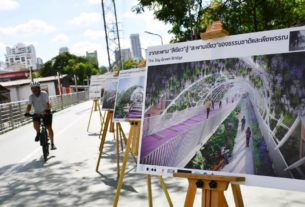
Sanitas, judge Christine Murray, and Pitupong, from left
Pitupong Chaowakul just loves an architectural challenge.
Pitupong Chaowakul just loves an architectural challenge. The man behind the building-design firm Supermachine happened to be on the same plane as Soopsip flying from London, where he’d claimed the Grand Prize in the Architectural Review Emerging Awards. (Soopsip had other reasons for being in being in Britain, but that’s literally another story.)
Also aboard was another architect, Sanitas Pradittasnee of Sanitas Studio, who’d picked up a “Commended with Merit” prize. So there was a lot of talk about steel, concrete and the art of putting them together aesthetically.
Pitupong won his award for 10 Cal Tower, the striking red-concrete labyrinth of a playground on Bangsaen
Beach in Chonburi. Evidently the folks in the coastal town – both the residents and the tourists – love climbing the 8.5-metre tower, which you ascend easily, like a staircase, but it meanders all over the place, so it’s a lot of fun.
Well, the playful project also won the hearts of judges at the London-based Architectural Review, the magazine that’s been handing out the Emerging Award for 17 years. It’s the world’s most prestigious prize for up-and-coming practitioners of the craft, giving them a goose toward wider recognition and success.
More than 300 architectural projects in Japan, the UK, France, Vietnam, the Philippines, China and Jordan were submitted for appraisal, and Pitupong brought the trophy home to Thailand. Previous winners have all gone on to great things, including Sou Fujimoto of Japan, Briton Thomas Heatherwick, Australian Sean Godsell, German Jurgen Mayer H and Li Xiaodong of China.
“The winner of the 2015 Award for Emerging Architecture reinterprets the traditional playground in a vertical labyrinth that brings children and adults together in a game of hide-and-seek with a difference,” the magazine judges declared in a statement.
Pitupong Chaowakul shares the credit with his skilled team – Sujinda Khawkam, Kasidis Peuktes and Mint Mintly – and with the project owner, Siam Cement Group, which provided “considerable technical and material support”. Their collaboration was part of a broader “community architecture” undertaking to mark the group’s 100th anniversary last year. Siam Cement has also invited two renowned Thai architecture firms to submit designs for Bangsaen Beach.
Architecture Preview noted “strong echoes of Escher’s 1953 lithograph ‘Relativity'”, referring to the great Dutch artist MC Escher and his impossibly twisting construction. “Indeed, Supermachine used Escher’s print to represent the idea of the tower’s complex circulation and also to make the prototype model.
“The challenge was to fit 10 complex paths into a compact construction site of 7.8×10.3 square metres on the public park’s existing lawn. The main load-bearing construction is located at the middle of the tower and it holds these 10 concrete paths, which are cantilevered and widen in the air. The width of the paths varies from 0.6 to one metre, so when you walk along them, you might touch someone or be touched by them. A new relationship could begin.”
Sanitas Pradittasnee was recognised for her project called “Khao Mo” (“Mythical Escapism”). The term khao mo literary means “a small hill”, and hers is a mountain of stacked mirrored cubes that reflect the surroundings. Passers-by never fail to spot themselves when strolling around Park@Siam between Chulalongkorn University and Siam Square. It’s like a giant mosaic selfie.
Source: http://www.nationmultimedia.com/life/Thai-architects-earn-praise-in-London-30274920.html
